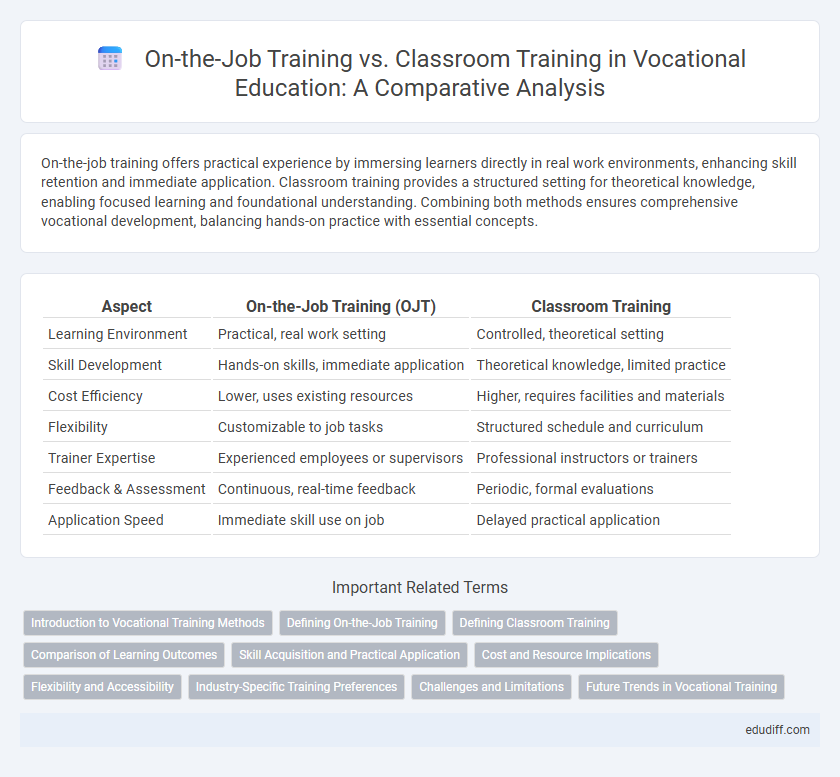On-the-job training offers practical experience by immersing learners directly in real work environments, enhancing skill retention and immediate application. Classroom training provides a structured setting for theoretical knowledge, enabling focused learning and foundational understanding. Combining both methods ensures comprehensive vocational development, balancing hands-on practice with essential concepts.
Table of Comparison
| Aspect | On-the-Job Training (OJT) | Classroom Training |
|---|---|---|
| Learning Environment | Practical, real work setting | Controlled, theoretical setting |
| Skill Development | Hands-on skills, immediate application | Theoretical knowledge, limited practice |
| Cost Efficiency | Lower, uses existing resources | Higher, requires facilities and materials |
| Flexibility | Customizable to job tasks | Structured schedule and curriculum |
| Trainer Expertise | Experienced employees or supervisors | Professional instructors or trainers |
| Feedback & Assessment | Continuous, real-time feedback | Periodic, formal evaluations |
| Application Speed | Immediate skill use on job | Delayed practical application |
Introduction to Vocational Training Methods
On-the-job training immerses apprentices in real work environments, accelerating skill acquisition through hands-on experience under expert supervision. Classroom training delivers foundational theories and structured knowledge essential for understanding vocational principles before practical application. Combining both methods enhances competency by blending theoretical understanding with applied practice, optimizing workforce readiness and performance outcomes.
Defining On-the-Job Training
On-the-job training (OJT) involves acquiring job-specific skills and knowledge directly in the work environment through practical experience under the supervision of experienced employees. This method enhances learning retention by allowing trainees to apply techniques immediately, fostering real-time problem-solving and productivity improvement. OJT is essential for developing hands-on competencies aligned with industry standards, making it a critical component in vocational education and workforce development.
Defining Classroom Training
Classroom training involves structured learning in a controlled environment where instructors deliver theoretical knowledge and practical skills using lectures, presentations, and group activities. This method emphasizes foundational concepts, standardized curriculum, and formal assessment to ensure consistent skill acquisition among trainees. It often complements on-the-job training by providing essential background before hands-on experience in vocational settings.
Comparison of Learning Outcomes
On-the-job training allows learners to acquire practical skills and real-time problem-solving abilities by engaging directly in workplace tasks, enhancing retention and immediate applicability. Classroom training provides structured theoretical knowledge and foundational concepts critical for understanding underlying principles but may lack hands-on experience. Studies show blending both methods yields superior learning outcomes, combining experiential learning with comprehensive theory comprehension.
Skill Acquisition and Practical Application
On-the-job training accelerates skill acquisition by immersing learners in real workplace scenarios, enabling immediate practical application and reinforcement of competencies. Classroom training provides a structured theoretical foundation, but often lacks the hands-on experience critical for mastering technical skills. Combining both methods ensures comprehensive vocational development, enhancing proficiency and workplace adaptability.
Cost and Resource Implications
On-the-job training reduces costs by utilizing existing workplace resources and allowing employees to learn while maintaining productivity, minimizing the need for external trainers or additional facilities. Classroom training incurs higher expenses due to dedicated venues, materials, and potential travel or accommodation costs for learners and instructors. Allocating resources for on-the-job training often results in more efficient workforce skill development with less disruption to operational budgets.
Flexibility and Accessibility
On-the-job training offers unparalleled flexibility by allowing learners to acquire skills directly in the workplace, adapting to real-time tasks and schedules. Classroom training, while less flexible, provides structured learning environments that may be limited by fixed times and locations. Accessibility in on-the-job training is often higher as it integrates learning into daily operations, reducing the need for travel and time away from work.
Industry-Specific Training Preferences
On-the-job training offers hands-on experience tailored to specific industry environments, enhancing practical skills and immediate application. Classroom training provides structured theoretical knowledge essential for understanding foundational concepts and regulatory standards in various trades. Industry-specific preferences often lean towards on-the-job methods for skilled trades, while sectors requiring rigorous safety protocols and certifications prioritize formal classroom instruction.
Challenges and Limitations
On-the-job training faces challenges such as inconsistent skill acquisition due to variable workplace conditions and limited exposure to theoretical knowledge, which may hinder comprehensive understanding. Classroom training limits real-world application opportunities and often struggles to simulate hands-on experiences, reducing practical skills development. Both methods face the limitation of balancing engagement and knowledge retention, impacting overall vocational competency growth.
Future Trends in Vocational Training
On-the-job training is increasingly integrated with digital simulations and augmented reality to enhance practical skill acquisition, while classroom training incorporates adaptive learning technologies and AI-driven content customization. Future trends in vocational training emphasize hybrid models combining experiential learning with virtual platforms to provide flexible, scalable education aligned with industry demands. Data analytics is leveraged to track learner progress, enabling personalized pathways that improve competency outcomes and workforce readiness.
On-the-job training vs Classroom training Infographic

 edudiff.com
edudiff.com